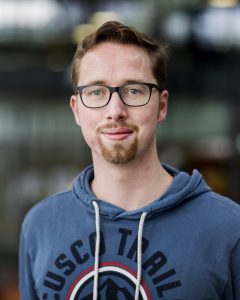
Hi, my name is Maik. Currently I am PhD student in the Plasma and Materials Processing group at Eindhoven University of Technology. Originally I am from Germany, where I obtained my Bachelor and Master in physics at the Ruhr-University Bochum. During my work I investigated plasma-surface interactions by emulating the plasma treatment using particle beam guns. In those years of learning about and working with plasma I came to one rather simple conclusion: Everything is better with plasma! Conscious that the underlying physics however can be very challenging, I decided to go for a PhD to deepen my understanding. The PIONEER project seemed to be the perfect opportunity to verify my theory about plasma by means of probably one of the biggest challenges for mankind today, the CO2 problem and therefore the climate change.
My work now deals with the efficient vibrational excitation of the CO2 molecule under admixture of additional components like N2 or H2O. During my stay here in Eindhoven I want to investigate the occurring processes by laser-based diagnostics before I am going to model them at my second host institution at IPFN – IST in Lisbon.
| Overview |  |
| ESR: | 13 |
| Title: | In Uncharted Waters – Energy transfer mechanisms in H2O-containing low-temperature CO2 conversion plasmas |
| Home Institution: | Eindhoven University of Technology (TU/e PMP) |
| 1st Supervisor: | Richard Engeln |
| Host Institution: | Instituto Superior Técnico, Universidade de Lisboa (IST-IPFN) |
| 2nd Supervisor: | Vasco Guerra |
| Industrial Partner: | AFS |
| Industrial Contact: | Florian Brehmer |
| Defence: | December 12 2023 |
Abstract
The intermittency of renewable energy sources must be addressed by a stable energy storage to enable the energy transition. Hydrocarbons, produced from the recycling of carbon dioxide (CO2), appear as ideal candidates due to their high energy per unit of volume and unit of mass. The utilisation of a stable molecule like CO2 is challenging though. Particularly for the most energyexpensive step, i.e. the splitting of CO2 into carbon monoxide and atomic oxygen, low-temperature plasmas (LTPs) promise high energy efficiency through the exploitation of their non-equilibrium character. Regardlessly, the reactive environments formed in the LTPs have the potential to promote chemistry that goes beyond mere CO2 splitting. Here, water (H2O) offers itself as reaction partner and abundant hydrogen source. The work in this thesis deals with the influence of H2O on CO2 plasma conversion, focussing on the processes occurring directly in the plasma from an experimental as well as a computational perspective. For this purpose, a pulsed CO2-H2O glow discharge at low pressure is studied. The glow discharge exhibits the desired non-equilibrium characteristics while simultaneously being relatively simple in geometry and therefore accessible for optical diagnostics as well as ideally suited for 0D kinetic modelling. Chapter 1 gives an overview of previous studies on the glow discharge as well as on the influence of H2O on CO2 plasma in general. At the very centre of the work are energy transfer processes occurring in the glow discharge, promoted through radiation and collisions. Radiative energy transfer is predominantly used in chapter 2 to experimentally probe the plasma by means of laser-induced fluorescence (LIF) spectroscopy. From H2O splitting in the discharge, the hydroxyl radical (OH) is produced and subsequently detected by LIF spectroscopy. In this work, first a new calibration scheme for OH LIF spectroscopy is developed and subsequently absolute OH number densities are measured for the first time in a CO2-H2O glow discharge, to the best of our knowledge. The OH density exhibits a steep increase with plasma ignition before it decays within the plasma on-time. Collisional energy transfer allows for the use of OH as a probe molecule to obtain a fingerprint of the collisional environment in the plasma. That way, it is possible to obtain the CO2 conversion degree and to confirm an increase in conversion when the plasma is turned off, as previously observed with other diagnostics. Further studies, using the conventional OH LIF scheme under low H2O admixture, are obstructed by light absorption and emission of metastable excited carbon monoxide CO(a3Π), as demonstrated in chapter 3. A new spectral overlap-free LIF scheme is proposed as a solution. Moreover, these findings indicate that the glow discharge stands out in terms of the significant presence of CO(a3Π) with respect to the amount of OH compared to other discharges in literature, in agreement with recent computational studies. Collisional energy transfer processes are also responsible for providing energy to the plasma in the first place. In fact, the light electrons get accelerated in the applied electric field and transfer their energy to the heavy particles through collisions. As such, the description of electron- heavy particle interactions by means of electron collision cross sections (CSs) is essential, particularly for plasma kinetic modelling. Part of this PhD work is hence the foundation of a complete and consistent CS set for H2O vapour, as shown in chapter 4, yielding excellent agreement with experimental electron transport coefficients. The set is established by using a two-term Boltzmann solver, guaranteeing wide-spread applicability. In particular, the CS set includes a large number of 147 rotational transitions, described by rotational CSs derived from the Born approximation assuming isotropic scattering. The latter assumption is lifted in chapter 5, where anisotropic scattering in rotational collisions with H2O molecules is taken into account and identified as crucial for an accurate description of the energy transfer. Henceforth, a second CS set is proposed. Additionally, a Monte Carlo simulations tool, being more accurate than the two-term approach, is used to prove that the applicability of the set is not limited to two-term Boltzmann solvers.
Links with other ESRs
- All ESRs: Comparison of efficiency obtained without N2
- ESRs 2-4: Comparison with modeling results
- ESRs 6-10: Use of CO2/N2 plasma in contact with developed catalyst

